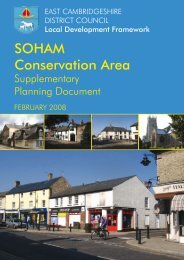East Cambridgeshire District Council Water Cycle Study Detailed ...
East Cambridgeshire District Council Water Cycle Study Detailed ...
East Cambridgeshire District Council Water Cycle Study Detailed ...
Create successful ePaper yourself
Turn your PDF publications into a flip-book with our unique Google optimized e-Paper software.
Stage 2 <strong>Water</strong> <strong>Cycle</strong> <strong>Study</strong>: Final Report<br />
Sept 2011<br />
26<br />
<strong>Cambridgeshire</strong> Horizons<br />
<strong>East</strong> <strong>Cambridgeshire</strong> – <strong>Detailed</strong> WCS<br />
watercourse upstream of the discharge and several of the watercourses in the study area do<br />
not have suitable flow information to use in the assessment. In these cases, load standstill<br />
calculations have been used. Load standstill has also been used for calculation of discharge<br />
consents to tidal waters, due to the highly managed nature of fenland drainage systems. A<br />
summary of which methodology has been used for each WwTW is provided in Table 3-2 below.<br />
Table 3-2: Modelling Method used – summary<br />
Modelling Steps<br />
WwTW RQP used<br />
Load<br />
Standstill<br />
used<br />
Soham <br />
Burwell <br />
Bottisham <br />
Haddenham <br />
Witchford <br />
Littleport <br />
Little<br />
Downham<br />
<br />
Witcham <br />
The first stage of the modelling exercise was to establish the discharge consent standards that<br />
would be required to meet ‘No deterioration’; this would be the discharge consent limit that<br />
would need to be imposed on AWS immediately at the time that the growth causes the flow<br />
consent to be exceeded. No deterioration is an absolute requirement of the WFD and any<br />
development must not result in a decrease in quality downstream from the current status.<br />
The second stage was to establish the discharge consent standards that would be required to<br />
meet future Good Status under the WFD classification in the downstream waterbody. This<br />
assessment was only carried out for WwTW discharging to waterbodies where the current<br />
status is less than Good (i.e. currently Moderate, Poor or Bad). This would be the discharge<br />
consent standard that may need to be applied in the future, subject to the assessments of<br />
‘technical feasibility’ and ‘disproportionate cost. Such assessment would be carried out as part<br />
of the formal Periodic Review process overseen by OFWAT in order to confirm that the<br />
proposed improvement scheme is acceptable.<br />
Modelling assumptions and input data<br />
Several key assumptions have been used in the water quality and consent modelling as<br />
follows:<br />
• the wastewater generation per new household is based on an assumed Occupancy Rate<br />
(OR) of 2.1 people per house 12 and an average consumption ion of 150 l/h/d (as set out in<br />
water use assumptions – section 1.6). The 150l/h/d figure makes an allowance for<br />
12 For modelling purposes AWS uses 2.3p/d (persons per dwelling) for new properties but factor in a declining occupancy in existing<br />
properties to balance, at a regional level, forecasts of population growth and housing targets. This brings it in line with the 2.1p/d use<br />
din this detailed study. AWS have confirmed (Rob Morris email, Thu 30/06/2011 09:41) that they consider the approach taken in this<br />
study as conservative and suitable for WCS purposes. It is the same approach that has been promoted in all the WCS in the AWS<br />
region






